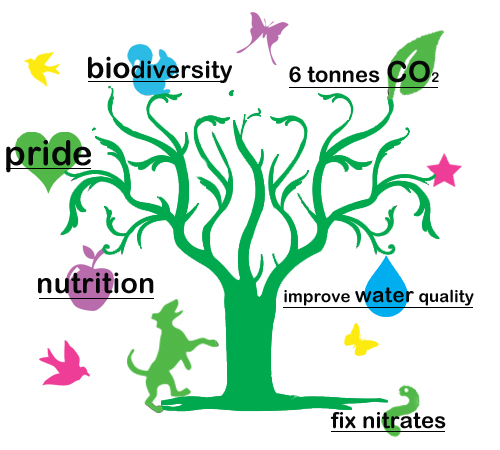deforestation
environment
environment-friendly
global warming
Multiwood
Multiwood Promos
PAPER
pine trees
Save Trees
trees
vegetarian
Water conservation
News
Benefits of Trees


Feb 19, 2015
Environmental Benefits
Trees can reduce air temperature by blocking sunlight. Further cooling occurs when water evaporates from the leaf surface. The conversion of water to air vapor a chemical process removes heat energy from the air.
A tree can be a natural air conditioner. The evaporation from a single tree can produce the cooling effect of 10 room size air conditioners operating 20 hours a day.
Deciduous trees block sunlight in the summer but allow sunlight to reach and warm your home in the winter place deciduous trees on the south and west sides of your home.
Trees can shade hard surface areas such as driveways, patios, building and sidewalks thus minimizing landscape heat load a build up of heat during the day that is radiated at night resulting in warmer temperatures. Ideally, 50 percent of the total paved surface should be shaded.
Evergreen trees can be used to reduce wind speed and thus loss of heat from your home in the winter by as much as 10 to 50 percent.
Trees absorb and block noise and reduce glare. A well placed tree can reduce noise by as much as 40 percent.
Fallen tree leaves can reduce soil temperature and soil moisture loss. Decaying leaves promote soil microorganism and provide nutrients for tree growth.
Trees help settle out and trap dust, pollen and smoke from the air. The dust level in the air can be as much as 75 percent lower on the sheltered side of the tree compared to the windward side.
Trees create an ecosystem to provide habitat and food for birds and other animals.
Trees absorb carbon dioxide and potentially harmful gasses, such as sulfur dioxide, carbon monoxide, from the air and release oxygen.


Trees help reduce surface water runoff from storms, thus decreasing soil erosion and the accumulation of sediments in streams. They increase ground water recharge and reduce the number of potentially harmful chemicals transported to our streams.
An acre of trees absorb enough carbon dioxide in a year to equal the amount produced when you drive a car 26,000 miles.
Trees cool the air, land and water with shade and moisture thus reduce the heat-island effect of our urban communities. The temperature in urban areas is often 9 degrees warmer than in areas with heavy tree cover.
Trees can help offset the buildup of carbon dioxide in the air and reduce the ” greenhouse effect.”
Trees create microclimates suitable for growing shade loving plants.
The American Forestry Association estimates that 100 million new trees would absorb 18 million tons of carbon dioxide and cut US air conditioning costs by $4 billion annually.
Dews and frosts are less under tree because less radiant heat is lost at night.
Personal and Social Benefits
Trees are the least expensive plants you can add to your landscape when you consider the impact they create due to their size.
A tree can add music to your life by attracting birds and other animals.
A tree can provide pleasant smells. A cherry tree can perfume the air with 200,000 flowers.
Hospital patients have been shown to recover from surgery more quickly when their hospital room offered a view of trees. They also had fewer complaints, less pain killers and left the hospital sooner.
Most of us respond to the presence of trees beyond simply observing their beauty. We feel serene, peaceful, restful and tranquil in a grove of trees. We are “at home” there.
Trees provide us with color, flowers, fruit, interesting shapes and forms to look at.
Trees can screen unattractive views, soften the sometimes harsh outline of masonry, metal, asphalt, steel, and glass.
Trees can seperate and define space thus providing a sense of privacy, solitude and security, and create a feeling of relaxation and well being.
Trees can serve as a living legacy for the next generation – thus linking us to near and distant generations
Lowered electricity bills are paid by customers when power companies build fewer new facilities to meet peak demands, use reduced amounts of fossil fuel in their furnaces and need fewer measures to control air pollution.
Trees can help direct pedestrian traffic, provide background and thus enhance the appearance of other landscape plants and our homes.
Trees help people reflect positively on life’ changes.
Trees have been reported as having a relaxing effect on students studying for exams.
Studies have documented that urban vegetation can result in slower heartbeats, lower blood pressure and more relaxed brain wave patterns.
Sound waves are absorbed by tree leaves and branches. A belt of trees 100 feet wide and 45 feet high can reduce highway noise by 50 percent. Prolonged exposure to noise can cause hypertension, higher cholesterol levels, irritability and aggressive behavior.
Community BenefitsTrees can create lasting impression on how a community is perceived by visitors and affect the mood and community pride of its residents.
Trees can enhance community economic stability by attracting businesses and tourists —–people linger and shop longer when trees are present.
Apartments and offices in wooded areas rent quicker and have a higher occupancy rate — workers in offices in wooded areas report more productivity and less absenteeism.
Property values of landscaped homes are 5 to 15% higher than those of non-landscaped homes and homes are quicker to resell than homes without trees.
Trees increase the humidity in the air, help increase ground water recharge, reduce soil erosion and storm water run-off thus reducing the amount of water we consume and the need for new water treatment plant and storm water structures. A study in Salt Lake City revealed the tree canopy reduced surface runoff by 11.3 million gallons following a 1 inch rain.
The feeling of community pride created by trees can help reduce crime.
By reducing heating and cooling cost, trees can reduce our dependance on oil and natural gas.
By absorbing and deflecting falling rain, trees can reduce the severity of floods.
By reducing carbon dioxide, dust and other potentially harm gasses in the air, our air quality is improved through lower levels of ozone, carbon monoxide and sulfur dioxide.
Trees make communities livable for people and their activities. People walk and jog more on streets with trees; children and adults have a cool place to play or relax in the summer, thus increasing their interaction with neighbors.




 Chat Now
Chat Now